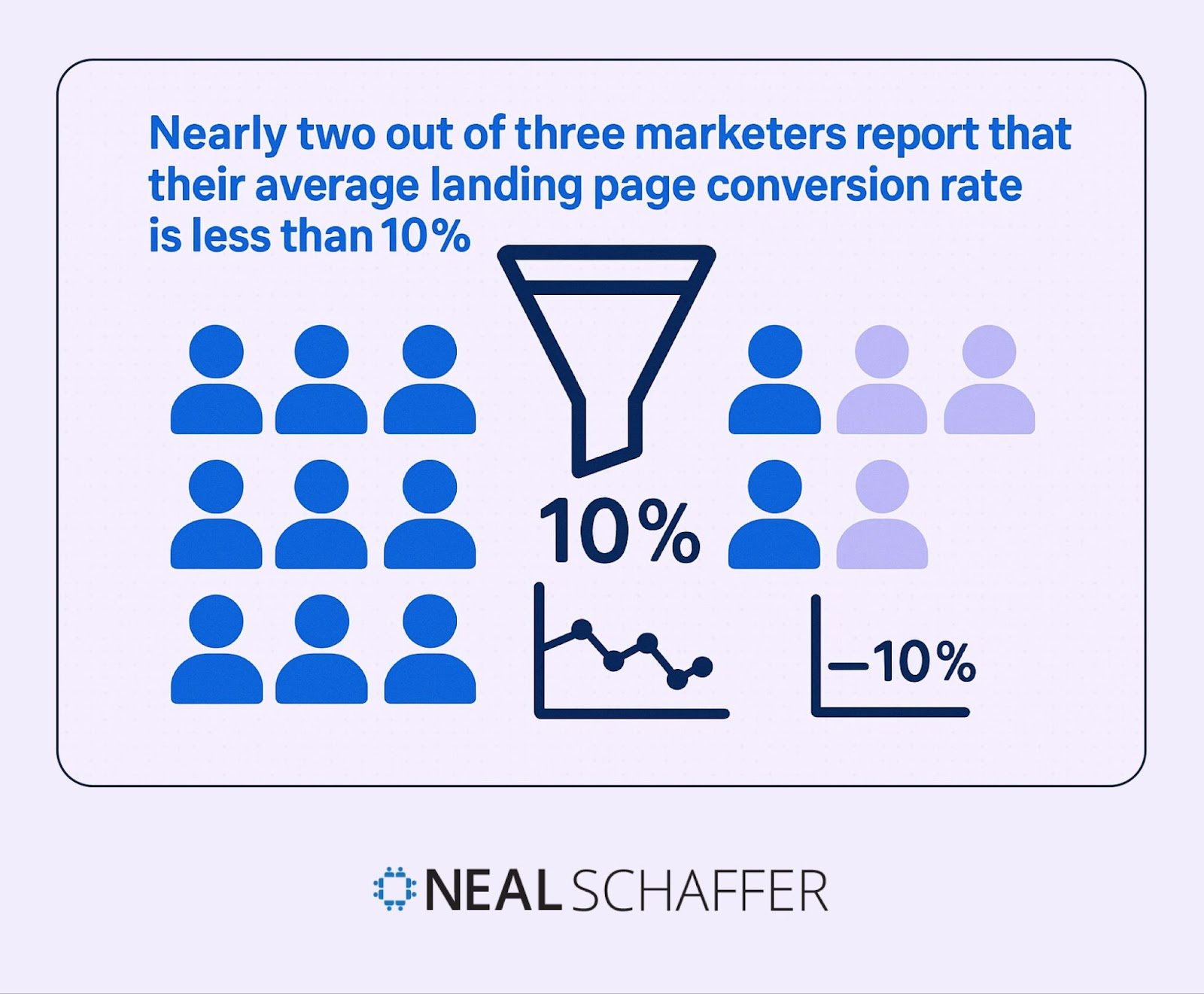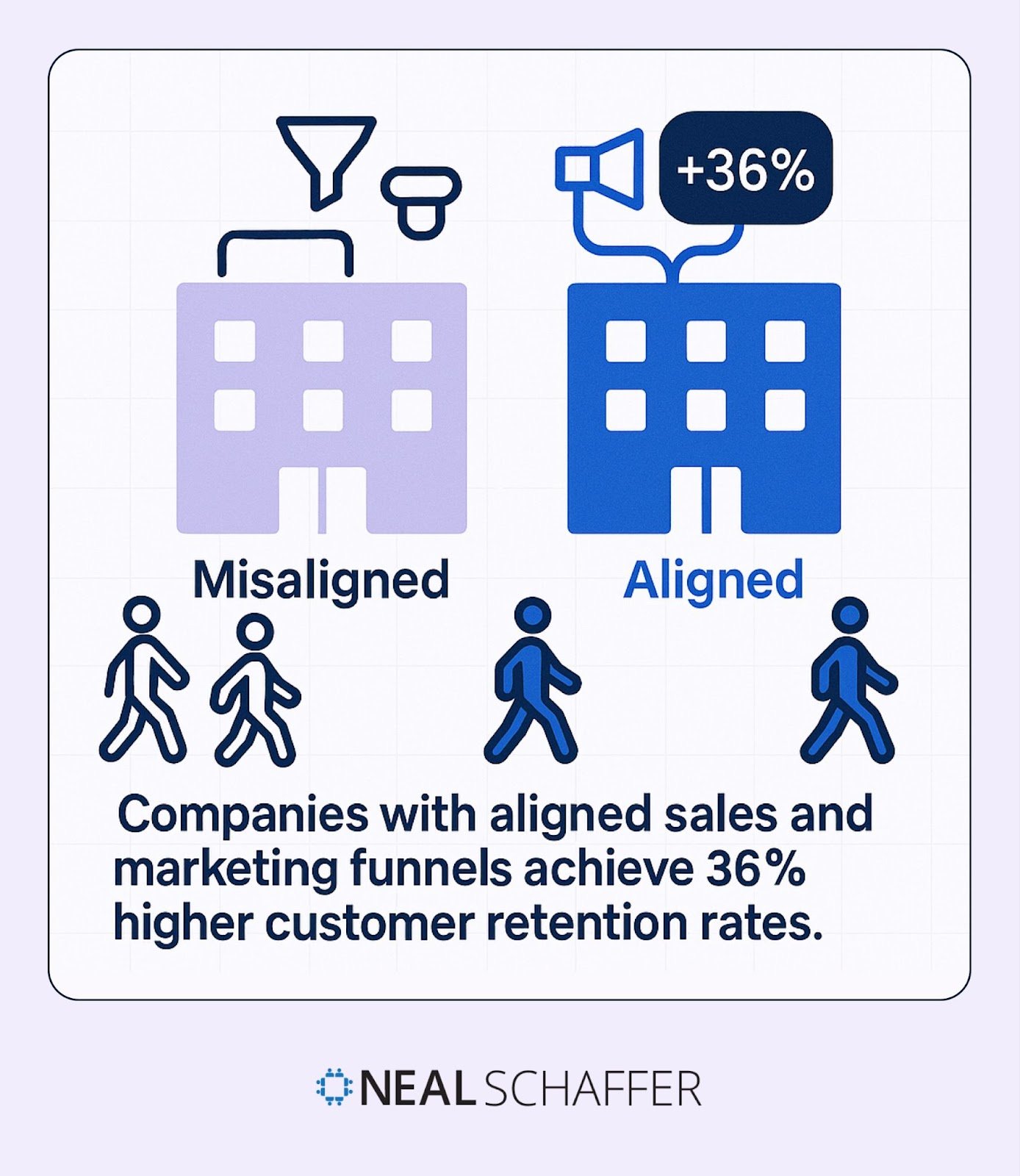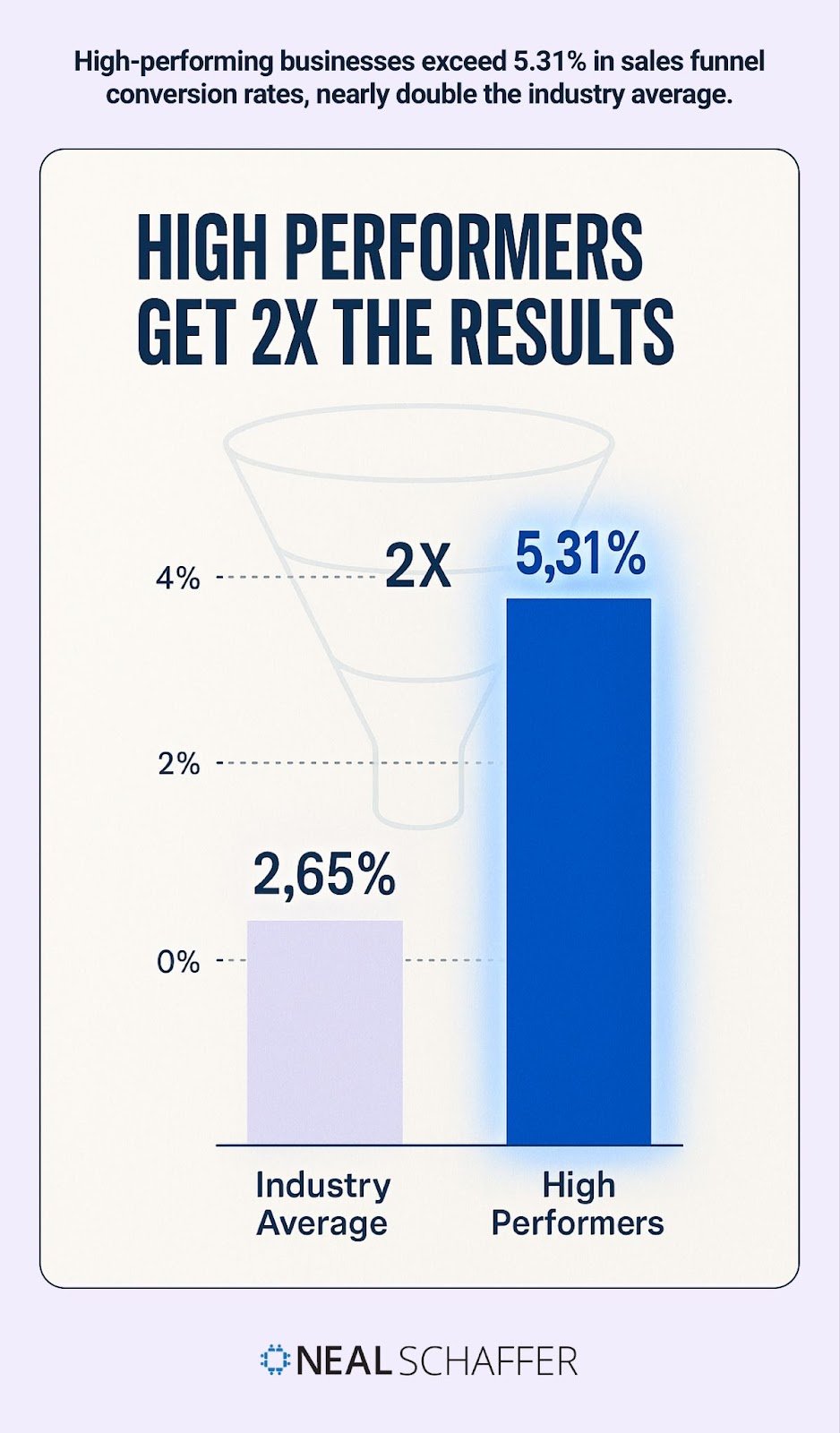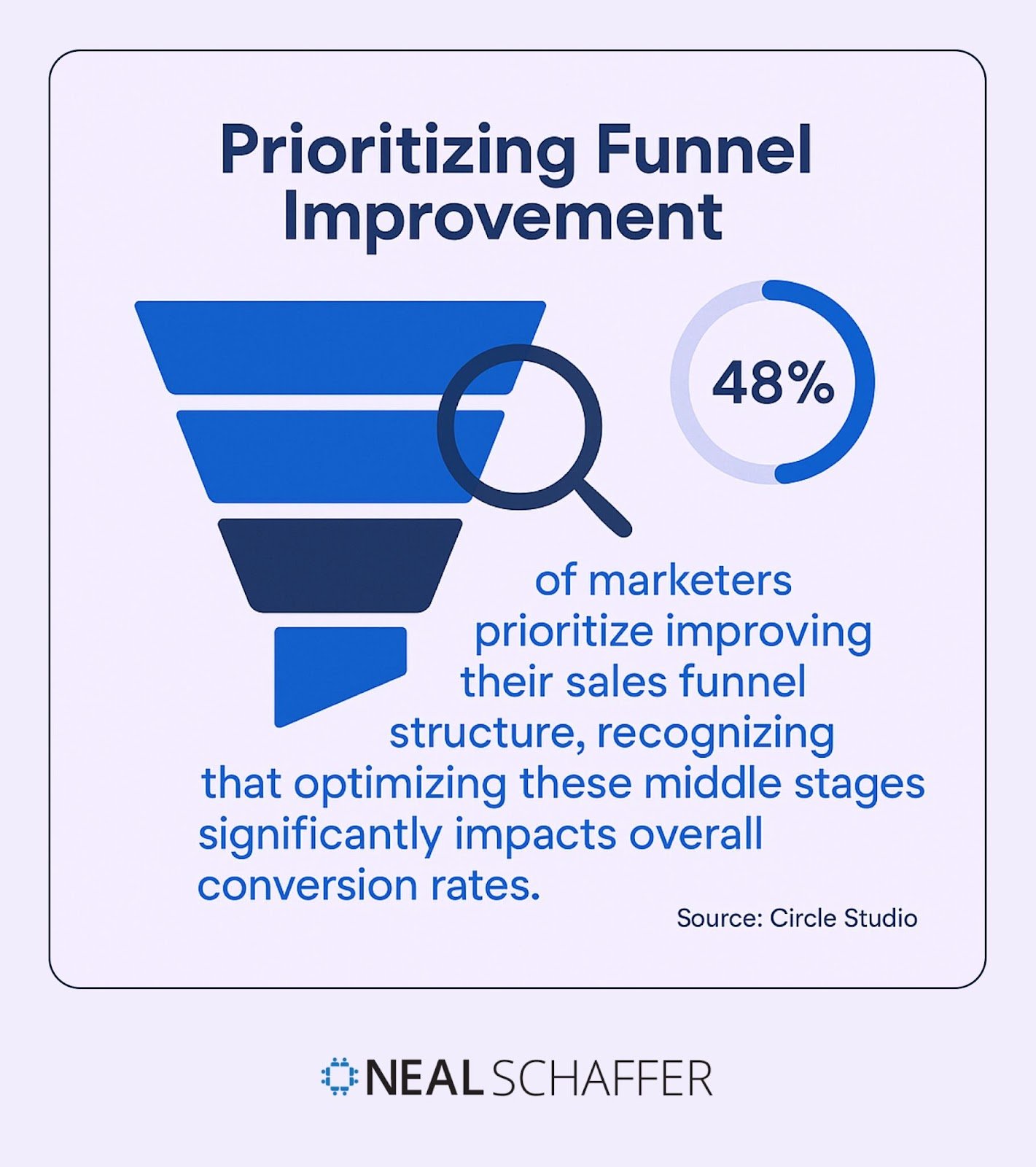The digital marketing funnel visualizes your customer’s journey. It maps their path from first discovering your brand to making a purchase. Every business needs this strategic framework to succeed online. As a Fractional CMO, this is the framework for which I help guide my clients. I also feature the digital marketing funnel and offshoots of it that I developed such as the funnel of digital relationships in my award-winning digital marketing playbook Digital Threads.
For growing businesses, a well-designed funnel makes all the difference. It transforms random marketing efforts into a cohesive system. Nearly two out of three marketers report that their average landing page conversion rate is less than 10%.

As a marketing professional, you need approaches that deliver measurable results. The funnel provides this structure. It helps you meet prospects at their current stage. You can then guide them forward with relevant content.
I’ve seen firsthand how proper funnel design transforms marketing effectiveness. It turns scattered tactics into a cohesive strategy. The results speak for themselves: more qualified leads, higher conversion rates, and better ROI.
What is a Digital Marketing Funnel?
A digital marketing funnel models the customer journey. It shows how prospects move from awareness to purchase. The funnel shape represents how your audience narrows at each stage.
Think of your funnel as a roadmap for customer acquisition. At the top, you cast a wide net to attract potential customers. As they progress, you provide increasingly targeted information. This addresses their specific needs and concerns.
The funnel concept offers several key benefits:
- Creates a systematic approach to lead conversion
- Identifies weak points in your customer acquisition process
- Guides targeted content creation for each stage
- Provides a framework for measuring marketing effectiveness
- Enables better alignment between marketing and sales teams


Companies with aligned sales and marketing funnels achieve 36% higher customer retention rates. Modern digital marketing funnels include multiple touchpoints across various channels. This requires careful planning to ensure a seamless customer experience. Your goal is to guide prospects naturally from one stage to the next.
The Stages of a Digital Marketing Funnel
Understanding each funnel stage helps you create targeted campaigns. These move prospects toward conversion. Let’s examine the six primary stages of an effective digital marketing funnel.
Each stage serves a specific purpose in the customer journey. Your marketing tactics should align with where prospects are in their decision process. This strategic approach maximizes conversion potential at every step.
1. Awareness Stage
The awareness stage is where potential customers first discover your brand. They recognize they have a problem but aren’t considering specific solutions yet. This stage focuses on visibility and initial connection.
Your primary goals during the awareness stage include:
- Maximizing visibility to your target audience
- Establishing initial brand recognition
- Providing value without heavy selling
- Building trust and credibility
The content types that perform best at this stage align with early problem recognition. They address common questions without pushing for immediate conversion. Let’s look at the most effective formats:
| Content Type | Purpose | Examples |
|---|---|---|
| Blog posts | Educational content addressing common problems | How-to guides, industry trends, problem-focused articles |
| Social media content | Build brand awareness and engagement | Shareable graphics, short videos, conversation starters |
| Search-optimized content | Capture organic traffic for problem-related searches | SEO-focused articles answering common questions |
| Video content | Engage audience with visual storytelling | Short explainer videos, educational content |
This initial stage establishes crucial first impressions. Focus on providing genuine value rather than pushing for immediate action. This approach builds trust and increases the likelihood of continued engagement.
2. Interest Stage
Once prospects know your brand, they enter the interest stage. They actively seek information about their problem and potential solutions. They might follow your social media, subscribe to your newsletter, or visit your blog regularly.
During the interest stage, your objectives shift to:
- Educating prospects about their problems in greater depth
- Beginning to position your solution as a potential fit
- Collecting contact information to nurture the relationship
- Establishing your expertise and authority
The most effective interest stage content captures contact information. This allows for ongoing communication and relationship building. Consider these high-performing formats:
| Content Format | Key Benefits | Contact Capture Method |
|---|---|---|
| Ebooks and whitepapers | Demonstrate expertise and provide in-depth information | Email signup form |
| Webinars | Interactive learning with direct expert access | Registration form |
| Email newsletters | Regular touchpoints with valuable information | Website signup form |
| Detailed guides | Comprehensive solutions to specific problems | Content upgrade offers |
The interest stage builds crucial relationships with potential customers. By providing value without sales pressure, you establish trust. This positions your brand as a helpful resource rather than just another vendor.
3. Consideration Stage
At the consideration stage, prospects have defined their problem clearly. They actively research and compare solutions. They know your offering and evaluate it against alternatives.
Your primary goals during this stage include:
Trying to Keep Up with Digital Marketing?
Just released: my new book to help small businesses, entrepreneurs, and marketers master digital marketing in today’s digital-first world.
Drawing on my Fractional CMO experience, Digital Threads simplifies complex strategies into clear, actionable steps for success.
Transform your business today—grab your copy! Click the cover or button below to buy on Amazon.


- Differentiating your product or service from competitors
- Addressing potential objections before they become barriers
- Providing evidence of your solution’s effectiveness
- Moving prospects closer to making a decision
Consideration stage content must directly address how your solution solves specific problems. It should also compare favorably to alternatives. Here’s what works best:
| Content Type | Purpose | Customer Concerns Addressed |
|---|---|---|
| Case studies | Show real-world results and applications | “Will this work for my specific situation?” |
| Product comparisons | Highlight advantages over alternatives | “Why should I choose this over competitors?” |
| Expert reviews | Provide third-party validation | “What do experts think about this solution?” |
| Free trials/demos | Allow hands-on experience | “How does this actually work in practice?” |
During this stage, address questions and objections directly. Be transparent about pricing, capabilities, and limitations. This builds trust and helps prospects determine if your solution fits their needs.
4. Intent Stage
The intent stage signals a significant shift in mindset. Prospects move from general research to showing clear purchase signals. They may request a quote, add items to a cart, or sign up for a free trial.
Your goals during the intent stage are:
- Remove any final obstacles to purchase
- Provide clear next steps toward conversion
- Offer incentives to complete the purchase
- Make the buying process as frictionless as possible
Effective tactics for the intent stage include limited-time offers, personalized recommendations, simplified checkout processes, and clear calls to action. These elements reduce friction and encourage completion.


High-performing businesses exceed 5.31% in sales funnel conversion rates, nearly double the industry average, by optimizing these critical intent-stage interactions.
The intent stage often leaks potential customers. Careful attention to user experience can significantly improve conversion rates at this critical juncture. Remove every possible barrier to taking the next step.
5. Evaluation Stage
During evaluation, prospects make their final assessment before purchasing. They compare specific features, review terms, and seek validation they’re making the right choice. This stage addresses last-minute concerns.
Your primary objectives at this stage include:
- Reinforcing your value proposition
- Addressing final concerns or questions
- Providing social proof to reduce purchase anxiety
- Making the decision process as easy as possible
Content that performs well at the evaluation stage includes customer testimonials, detailed FAQs, money-back guarantees, and live chat support. These elements provide reassurance at a critical decision point.
The evaluation stage represents your last opportunity to address objections. Being responsive and transparent during this phase significantly impacts conversion rates. Answer questions quickly and completely.
6. Purchase Stage
The purchase stage is when a prospect becomes a customer. While this might seem like the end of the funnel, it’s actually a critical transition point for ongoing customer relationships.
Your goals during the purchase stage include:
- Creating a smooth, frictionless transaction process
- Setting appropriate expectations for next steps
- Expressing appreciation for the customer’s business
- Beginning the onboarding process
After the purchase, focus on clear confirmation messaging, immediate access to the product or service, helpful onboarding materials, and open support channels. The purchase should feel like the beginning of a relationship, not the end of a transaction.
Optimizing Your Digital Marketing Funnel
Creating an effective digital marketing funnel requires ongoing refinement. Each stage presents unique optimization opportunities. Let’s explore key strategies for improving your entire funnel.
Successful optimization starts with understanding how your content marketing funnel currently performs. Track metrics at each stage to identify bottlenecks and opportunities for improvement.
Awareness Stage Optimization
To maximize your awareness stage effectiveness:
- Conduct thorough keyword research to understand what your audience seeks
- Create content addressing common pain points and questions
- Optimize for both search engines and user experience
- Leverage multiple channels to expand reach
The awareness stage benefits from broad content that captures attention. Focus on high-quality, valuable information that establishes your expertise without pushing for immediate conversion.
Interest and Consideration Stage Optimization
For the middle of your funnel, focus on:
- Developing targeted content for specific audience segments
- Building email nurture sequences that provide value over time
- Using retargeting campaigns to stay top-of-mind
- Creating clear pathways toward conversion


48% of marketers prioritize improving their sales funnel structure, recognizing that optimizing these middle stages significantly impacts overall conversion rates.
Intent and Evaluation Stage Optimization
To improve conversion at the bottom of your funnel:
- Simplify forms and checkout processes to reduce friction
- Address common objections directly in your content
- Implement exit-intent strategies to recover potential drop-offs
- Test different calls to action and offers
Even small improvements in conversion rates at these stages can significantly impact your bottom line. Focus on removing barriers and providing reassurance.
Cross-Stage Optimization Tactics
Some optimization strategies apply across multiple funnel stages. These approaches can improve overall performance throughout the customer journey:
| Optimization Tactic | Primary Benefit | Implementation Complexity | Typical Impact |
|---|---|---|---|
| A/B testing | Data-driven decision making | Medium | High |
| Personalization | Improved relevance and engagement | Medium-High | High |
| Marketing automation | Scalable, consistent follow-up | High | High |
| User experience improvements | Reduced friction and abandonment | Medium | Medium-High |
| Analytics implementation | Better visibility into performance | Medium | Enables other optimizations |
Successful funnel optimization requires a systematic approach. Focus on one stage at a time, measure results carefully, and implement changes based on data rather than assumptions.
Measuring Digital Marketing Funnel Success
To optimize your marketing funnel effectively, establish clear metrics for each stage. These measurements help identify bottlenecks and improvement opportunities. The right metrics drive better decision-making.
What is digital marketing success if not measurable? Proper tracking allows you to see exactly where prospects engage or drop off. This visibility is essential for continuous improvement.
Key Metrics by Funnel Stage
Each stage of your funnel requires different metrics to assess performance. Understanding what to measure at each point helps focus your optimization efforts:
| Funnel Stage | Key Metrics | What They Tell You |
|---|---|---|
| Awareness | Traffic, impressions, reach | How many potential customers you’re reaching |
| Interest | Engagement rate, time on page, bounce rate | How compelling your initial content is |
| Consideration | Email sign-ups, content downloads, return visits | How many prospects are actively researching |
| Intent | Demo requests, cart additions, pricing page visits | How many prospects show purchase signals |
| Evaluation | Cart abandonment rate, sales call bookings | Where final decisions are being delayed |
| Purchase | Conversion rate, average order value | The bottom-line effectiveness of your funnel |
Beyond individual stage metrics, track these cross-funnel measurements:
- Overall conversion rate from top to bottom of funnel
- Cost per acquisition (CPA)
- Customer lifetime value (CLV)
- Return on marketing investment (ROMI)
Your email marketing conversion rate often provides valuable insights into middle-funnel effectiveness. This metric shows how well you’re nurturing prospects toward purchase decisions.
Establishing a consistent measurement framework allows you to track improvements over time. Make data-driven decisions about where to focus your optimization efforts for maximum impact.
Common Digital Marketing Funnel Mistakes to Avoid
Even experienced marketers make mistakes when designing digital marketing funnels. Knowing these common pitfalls helps you avoid them. Let’s examine the most frequent errors and how to prevent them.
Recognizing these issues early can save significant time and resources. Most importantly, it helps maintain prospect trust throughout their journey with your brand.
1. Focusing Too Much on Top-of-Funnel Activities
Many marketing teams place excessive emphasis on awareness-stage activities. Content creation and social media are important, but they won’t drive revenue without equal attention to conversion strategies.
Balance your efforts across all funnel stages. Allocate resources proportionally to each phase of the customer journey. This ensures prospects continue moving toward purchase rather than getting stuck at awareness.
2. Creating Disconnected Customer Experiences
When different teams manage different funnel parts without coordination, prospects experience jarring transitions. Inconsistent messaging reduces trust and conversion rates. Your funnel should feel like one cohesive journey.
Implement cross-team collaboration and unified messaging. Create a consistent brand voice and experience across all touchpoints. This coherence builds confidence and maintains momentum toward conversion.
3. Neglecting Mobile Users
With more than half of web traffic coming from mobile devices, non-optimized funnels create significant barriers. Every stage of your funnel must provide a seamless mobile experience to maximize conversion potential.
Test your entire funnel on multiple devices. Ensure forms, checkout processes, and content display properly on smaller screens. Mobile optimization is no longer optional—it’s essential.
4. Overlooking Retargeting Opportunities
Many prospects need multiple touchpoints before converting. Without strategic retargeting, you miss opportunities to re-engage interested prospects who didn’t convert initially.
Implement retargeting campaigns for funnel drop-offs. Create specific messaging based on which stage they abandoned. This personalized approach brings prospects back into your funnel more effectively.
5. Rushing the Relationship
Pushing for conversion too early can alienate prospects still in research mode. Respect the buyer’s journey by providing value appropriate to each stage rather than jumping to sales pitches.
Match your content and offers to the prospect’s current stage. Build trust gradually through helpful information before asking for the sale. This patient approach yields higher conversion rates and customer satisfaction.
The Future of Digital Marketing Funnels
The digital marketing funnel continues to evolve with changing consumer behavior and technology. Understanding emerging trends helps you stay ahead. Future-focused strategies maintain your competitive advantage.
Adapting your content strategy to these trends ensures your funnel remains effective as marketing landscapes shift. The most successful organizations view their funnels as evolving systems.
From Linear to Cyclical Models
Traditional linear funnels are giving way to cyclical models. These recognize the non-linear nature of modern customer journeys. They emphasize ongoing relationships rather than one-time transactions.
Modern funnels incorporate post-purchase stages like adoption, retention, expansion, and advocacy. This approach maximizes customer lifetime value while generating new leads through referrals.
Increased Personalization
Advances in AI and data analytics enable unprecedented personalization levels. Future funnels will deliver highly tailored experiences based on individual behaviors, preferences, and needs.
Implement progressive profiling to gather information gradually. Use this data to personalize content and offers at each funnel stage. This relevance dramatically improves engagement and conversion rates.
Omnichannel Integration
As consumers move seamlessly between channels and devices, successful funnels provide consistent experiences regardless of interaction point. This integration requires sophisticated tracking and content delivery systems.
Map customer journeys across all potential touchpoints. Ensure messaging consistency and data sharing between digital marketing platforms. This cohesive approach prevents prospects from falling through the cracks.
Focus on Customer Advocacy
Advanced marketing funnels now extend beyond purchase to cultivate customer advocacy. This approach transforms customers into brand ambassadors who drive new prospects into your funnel.
Create formal advocacy programs with incentives for referrals and testimonials. Provide shareable content that helps customers promote your brand. This strategy leverages existing customer relationships to fuel growth.


Conclusion
A well-designed digital marketing funnel is essential for converting leads into customers. By understanding each stage and creating targeted experiences, you guide prospects through their buying journey more effectively.
Remember that optimization never ends. Regularly measure performance at each stage, test new approaches, and refine based on data. The most successful funnels evolve with changing customer needs and technologies.
Whether building your first funnel or refining an existing one, focus on creating value at each customer journey stage. This value-first approach builds trust and drives conversions.
By implementing the strategies outlined in this guide, you’ll create marketing funnels that not only convert more effectively but also build lasting customer relationships. These relationships drive sustainable business growth.
The digital marketing funnel remains a powerful framework for organizing your marketing efforts. With strategic implementation and continuous optimization, it becomes your roadmap to consistent growth and customer acquisition.
Actionable advice for your digital / content / influencer / social media marketing.
Join 13,000+ smart professionals who subscribe to my regular updates.

